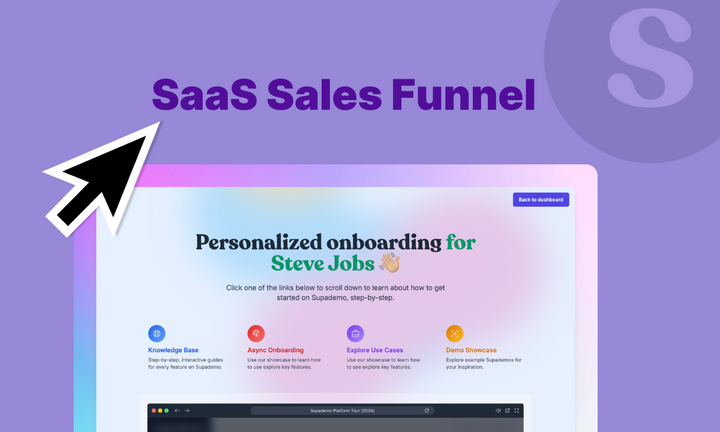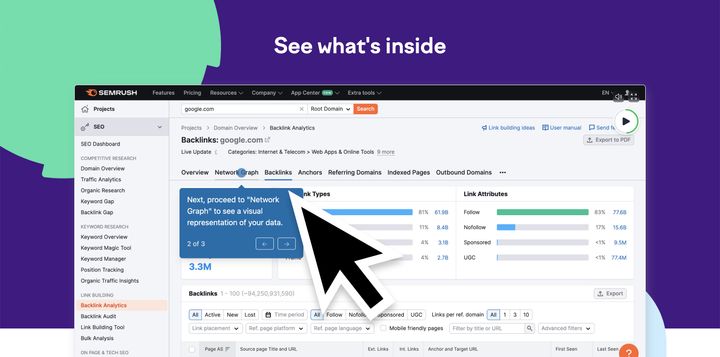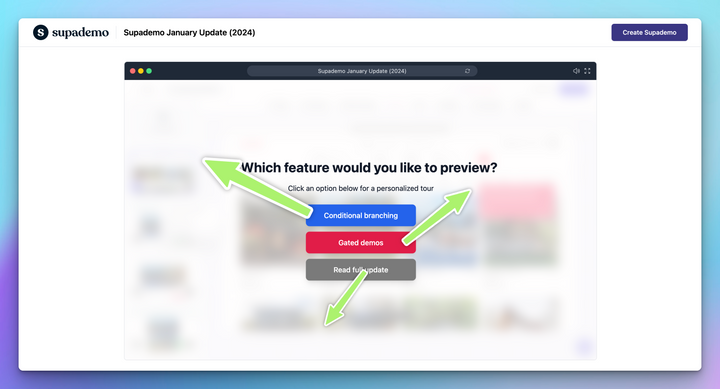In B2B sales, up to 90% of the buying journey is actually completed right before the buyer connects with the sales rep. A well-designed SaaS sales funnel provides the framework for predictable revenue growth.
It maps every touchpoint in your customer journey, identifies conversion bottlenecks, and creates systematic processes for moving prospects through each decision stage. Companies with optimized funnels can forecast revenue accurately and scale their operations with confidence.
In this guide, we show you exactly how to build a SaaS sales funnel that converts prospects into customers, with effective SaaS funnel optimization tips and real-world examples. Let’s get started!
- Multi-stage approach: B2B SaaS funnels require distinct stages from awareness to advocacy, each with specific goals and metrics that align with buyer behavior patterns.
- Content alignment: Match your content and messaging to each funnel stage to address specific buyer needs, concerns, and decision-making criteria.
- Interactive experiences: Product demos and trials create hands-on experiences that help prospects understand value and build confidence in your solution.
- Lead qualification: Implement behavioral and demographic scoring systems to prioritize high-value prospects and focus sales efforts on the most promising opportunities.
- Lifecycle focus: Retention and expansion strategies matter as much as acquisition, since keeping existing customers costs significantly less than finding new ones.
- Technology integration: Use Supademo for interactive demos, CRM systems for lead management, and analytics tools for performance tracking and optimization.
- Continuous optimization: A/B testing landing pages, email sequences, and demo experiences helps identify improvements that compound over time.
- Team alignment: Marketing, sales, and customer success teams must work together around shared funnel metrics and revenue goals for maximum effectiveness.
What is a SaaS sales funnel?
A SaaS sales funnel is a systematic process that guides potential customers through stages of awareness, consideration, and decision-making until they become paying subscribers. Unlike traditional sales funnels focused on one-time purchases, SaaS funnels prioritize recurring revenue and long-term customer relationships.
The funnel represents your customer journey as connected stages, each designed to move prospects closer to purchase while filtering out unqualified leads. At the top, you attract many prospects through various marketing channels. As they progress through stages, the audience becomes smaller but more qualified and likely to convert.
For example, a project management SaaS can attract thousands of monthly website visitors through content marketing and SEO. A portion of these visitors will download resources or sign up for trials, with a smaller group eventually becoming paying customers. Each stage has measurable conversion rates that provide insights for optimization.
Why do SaaS companies need a sales funnel?
SaaS businesses face unique challenges that make structured funnels essential for sustainable growth and predictable revenue.
Here are the key reasons why every SaaS company needs a well-defined sales funnel:
- Rising acquisition costs: The average SaaS customer acquisition cost has increased by 60% in the past five years, making efficient conversion processes crucial for maintaining healthy unit economics.
- Complex buying decisions: According to Gartner, today’s B2B buying committees typically involve 5 to 11 stakeholders and lengthy evaluation cycles, making systematic nurturing essential.
- Self-service expectations: Research shows that 75% of B2B buyers prefer a rep-free experience during their research and evaluation, demanding strong educational content and product-led experiences.
- Revenue predictability: Investors and leadership teams demand consistent growth metrics that can only come from measurable, repeatable processes.
- Scalability requirements: Manual, ad-hoc sales approaches don't scale effectively as companies grow, while systematic funnels can handle increased volume efficiently.
- Competitive differentiation: Research shows that 80% of B2B buyers don’t engage sales until they’re about 70% through their buying journey. Companies that provide strong content, product experiences, and streamlined sales cycles stand out and win deals earlier.
What are the stages of a SaaS sales funnel?
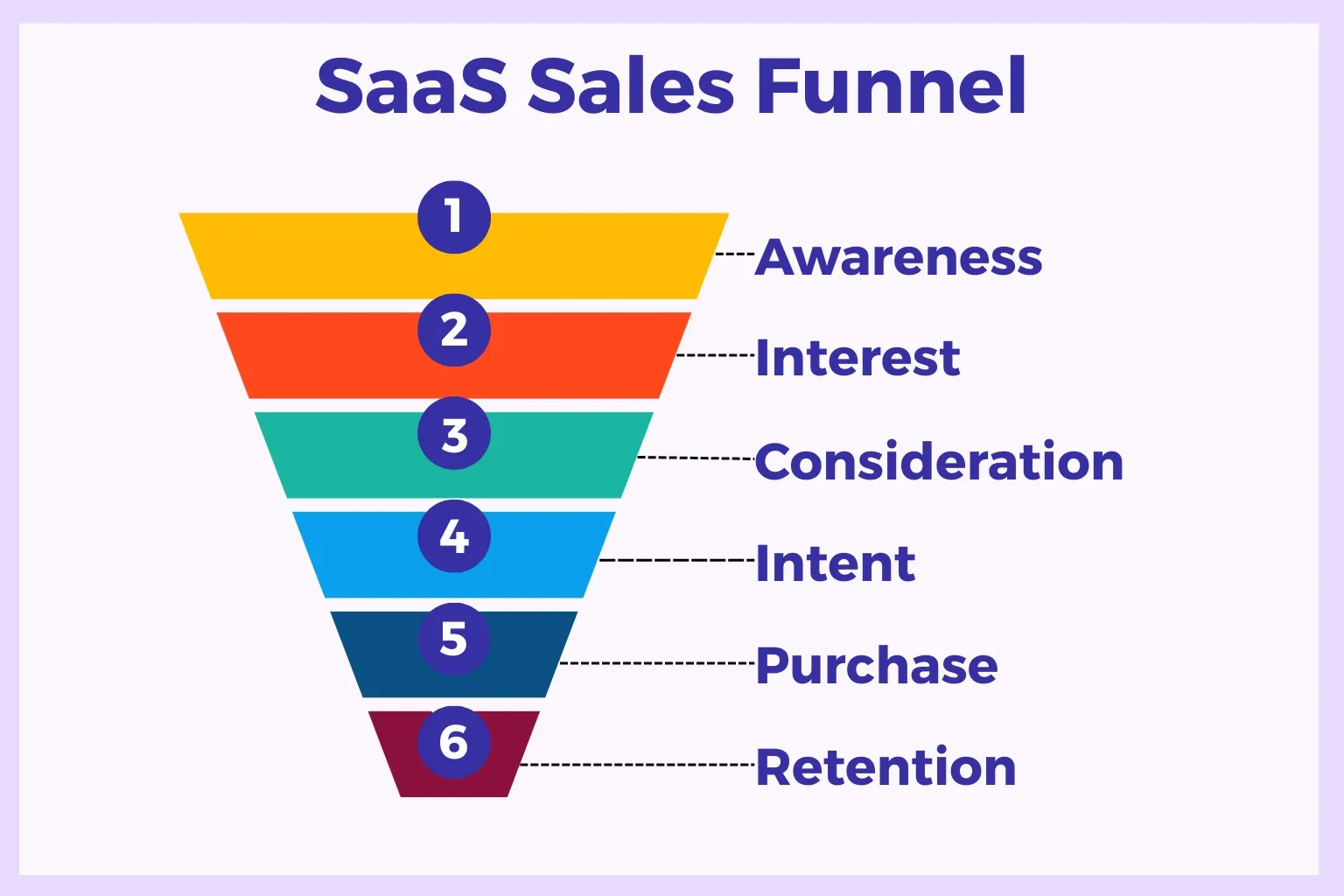
A complete B2B SaaS funnel typically includes six distinct stages, each serving specific purposes in the customer journey. Knowing about these stages helps you create targeted experiences that address prospects’ needs and concerns at the right moments.
1. Awareness stage
Prospects first discover your solution exists and begin recognizing they have a problem worth solving. This stage focuses on educational content that addresses pain points without heavy product promotion.
Content marketing, SEO optimization, and social media drive traffic to blog posts, guides, and resources that establish your expertise. For example, a marketing automation SaaS can create content about lead nurturing best practices, attracting marketing managers who struggle with prospect engagement.
The goal is building trust and authority while capturing contact information through valuable lead magnets like templates, checklists, or industry reports.
2. Interest stage
Qualified prospects actively research solutions and begin comparing available options. They consume more detailed content like case studies, webinars, and product comparison guides that help them understand different approaches to solving their problems.
This stage often involves gated content that provides deeper insights in exchange for contact information and demographic details. Prospects indicate growing interest through behaviors like attending webinars, downloading multiple resources, or visiting pricing pages.
Sales teams typically aren't involved yet, as prospects prefer self-service research before engaging in direct conversations.
3. Consideration stage
Prospects evaluate your solution against competitors and internal alternatives while building business cases for potential purchases. SaaS product demos, free trials, and consultative conversations help them understand fit and value proposition.
Interactive demos work particularly well during this stage, allowing prospects to explore your product interface and see how specific features address their use cases. This hands-on experience builds confidence and excitement while qualifying their technical requirements.
4. Intent stage
Qualified prospects indicate strong buying interest through high-value actions like requesting pricing information, scheduling sales calls, or extending trial periods. Sales teams focus on understanding detailed requirements and building compelling business cases.
This stage involves discovery calls, technical evaluations, and stakeholder meetings that uncover decision criteria, budget parameters, and implementation timelines. The goal is to advance qualified opportunities through formal evaluation processes.
5. Purchase Stage
Prospects become customers through contract negotiation, legal review, and procurement processes. The focus shifts to removing friction, addressing final objections, and ensuring smooth implementation planning.
Sales teams work closely with legal, security, and implementation specialists to navigate organizational requirements while maintaining momentum toward contract signature.
6. Retention & Expansion Stage
Existing customers receive ongoing value through customer success programs, feature adoption initiatives, and expansion opportunities. Happy customers become advocates who drive referrals, case studies, and positive reviews.
This stage includes onboarding support, regular check-ins, and strategic account management that identifies opportunities for account growth and renewal.
Tips to optimize your SaaS funnel
Successful funnel optimization requires systematic testing and improvement across every stage. Here are proven strategies that create measurable improvements in conversion rates and revenue growth:
1. Target high-intent keywords
Start by identifying search terms that reveal buying intent rather than casual browsing. For instance, prospects searching for "best CRM software for small business" or "[Competitor] alternatives" are actively evaluating solutions, making them far more valuable than those searching for "what is CRM."
Use tools like Semrush or Ahrefs to find competitor keywords and comparison terms. For example, if you offer project management software, target phrases like "Asana vs Trello" or "project management software for remote teams." These longer, specific phrases often convert better despite lower search volumes.
Create dedicated landing pages for high-intent keywords with content that directly addresses the search query. A prospect searching "email marketing automation for e-commerce" should land on a page that specifically explains your email automation features for online retailers, not a generic product overview.
2. Implement progressive profiling
Stop asking for everything up front. Salvatore Surra, the Director of Content & SEO at Seamless.AI, highlights:
“Reducing barriers and optimizing the top of the funnel at point of entry will increase more usage. When I go to a new site and see a complicated form or multi-step process, I think what a wasted opportunity.”
Most prospects will abandon forms that request company size, budget, phone number, and job title before they've experienced any value from your brand. Start with just an email address to access your lead magnet or trial signup.
Gather additional information through subsequent interactions as prospects demonstrate higher engagement. For example, after someone downloads three resources, ask for their company size to send more targeted content. When they attend a webinar, request their role to customize follow-up emails.
Use smart forms that remember returning visitors and ask for new information each time. So, for instance, a prospect who previously gave their email and company name will see fields for industry and team size on their next form submission, building a complete profile over multiple touchpoints.
3. Create interactive product experiences
Replace static screenshots and demo videos with hands-on product experiences that let prospects explore your interface. Interactive demos show rather than tell, giving prospects confidence that your solution actually works for their specific needs.
Build scenario-based demos that address common use cases. For instance, if you sell inventory management software, create separate demo experiences for retail stores, restaurants, and warehouses. Each demo should show workflows specific to that industry rather than generic feature overviews.
Track engagement within your demos to understand prospect interests. When a prospect spends time exploring your reporting features but skips integration options, your sales team knows to focus on analytics capabilities during follow-up conversations. Supademo makes this easy by providing detailed engagement analytics for every demo interaction.
4. Optimize email nurture sequences
Design different email tracks for prospects at various funnel stages rather than sending everyone the same generic sequence. Awareness-stage emails should focus on education and problem-solving, while consideration-stage messages can include product comparisons and customer stories.
Use behavioral triggers instead of time-based automation. Send a demo follow-up immediately after someone completes your trial signup, not three days later when the experience is no longer fresh. When prospects visit your pricing page multiple times, trigger a sequence about ROI and implementation rather than basic feature education.
Write emails that provide genuine value in every message. Share industry benchmarks, how-to guides, or exclusive insights that help prospects succeed whether they buy from you or not. This approach builds trust and keeps your emails from feeling purely promotional.
Andrew Byzov, the CMO & Head of Sales at AcademyOcean AI-LMS shares:
“Making sure that leads are properly qualified and nurtured before sales picks them up is the thing that improves conversion efficiency and avoids wasted demos.”
5. Develop lead scoring models
Combine demographic information with behavioral signals to identify your most promising prospects. For instance, a marketing director at a 100-person company who has downloaded three resources and attended a webinar scores higher than a small business owner who signed up with a personal email address.
You can set clear scoring thresholds that trigger specific actions. For instance, prospects scoring 0-25 points will receive automated nurture emails, while those scoring 75+ points get immediate sales outreach. Prospects in the middle range could receive targeted content based on their interests and engagement patterns.
Review and adjust your scoring model quarterly based on which leads actually convert to customers. If you discover that prospects who visit your integrations page are twice as likely to buy, increase the point value for that behavior in your scoring system.
Mike Khorev, the founder and CEO of Nine Peaks Media, highlights:
“Fix the leaks at the awareness stage. Most SaaS brands overspend on top-of-funnel traffic and under-invest in refining it. Get clear on who actually converts, then filter out the rest. Better targeting = lower CAC, better leads.”
6. Test landing page elements
Focus your testing efforts on elements that directly impact decision-making. Your headline and value proposition have more impact on conversions than button colors or fonts. Test different ways of explaining your core benefit, like "Reduce manual data entry by 80%" versus "Automate your workflow processes."
Experiment with social proof placement and formats. Some audiences respond better to customer logos, while others prefer detailed case studies or user testimonials. Test positioning social proof above the fold versus integrating it throughout the page content.
Test form length and field requirements systematically. Start with email-only forms, then test adding one field at a time to find the optimal balance between conversion rate and lead quality. Sometimes, a longer form that generates fewer but higher-quality leads produces better results than a short form with many unqualified submissions.
3 Real-world SaaS funnel examples
Learning from successful companies helps identify strategies that work across different markets and business models. These examples show how leading SaaS companies structure their funnels for maximum effectiveness.
1. ClickUp
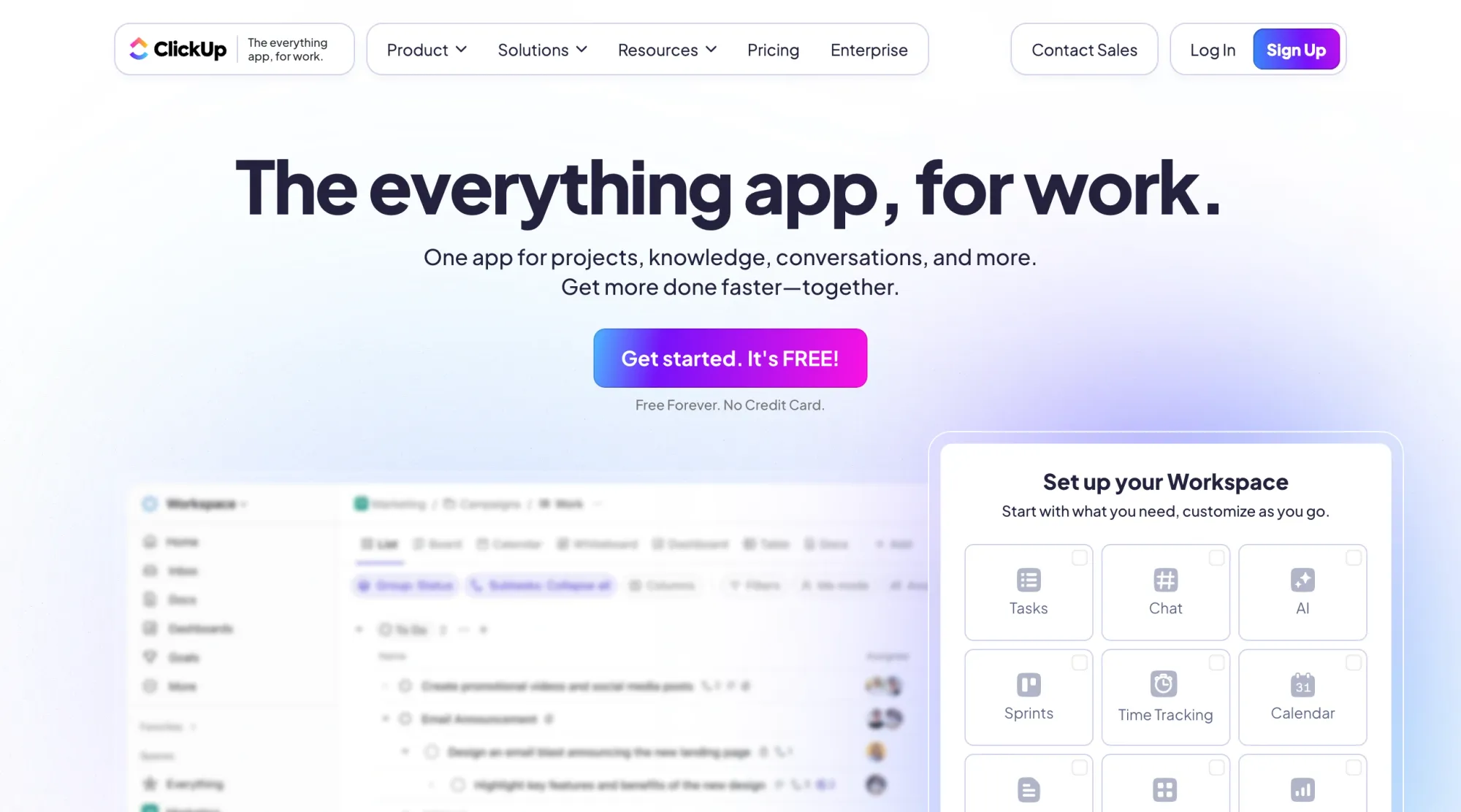
ClickUp built its SaaS funnel around a clear value proposition: replace multiple productivity tools with one comprehensive platform. Their approach targets prospects already using competing solutions and demonstrates superior capabilities through direct comparison.
- Top-of-funnel targeting: ClickUp publishes comparison content for high-intent keywords like “ClickUp vs Asana” and “best Notion alternatives.” Detailed comparisons, migration guides, and switching tutorials capture prospects already evaluating project management tools.
- Educational content strategy: Beyond comparisons, ClickUp shares guides on productivity, collaboration frameworks, and project management best practices. This content builds authority while attracting prospects who may not yet know they need a better tool.
- Template-driven conversion: A large template library speeds time-to-value. Marketing teams can use campaign management templates, while developers get sprint planning and bug tracking setups out of the box.
- Freemium expansion model: A generous free tier lets entire teams try core features. Upgrade prompts appear when collaboration limits are reached or advanced features are needed, driving natural conversions.
2. Typeform
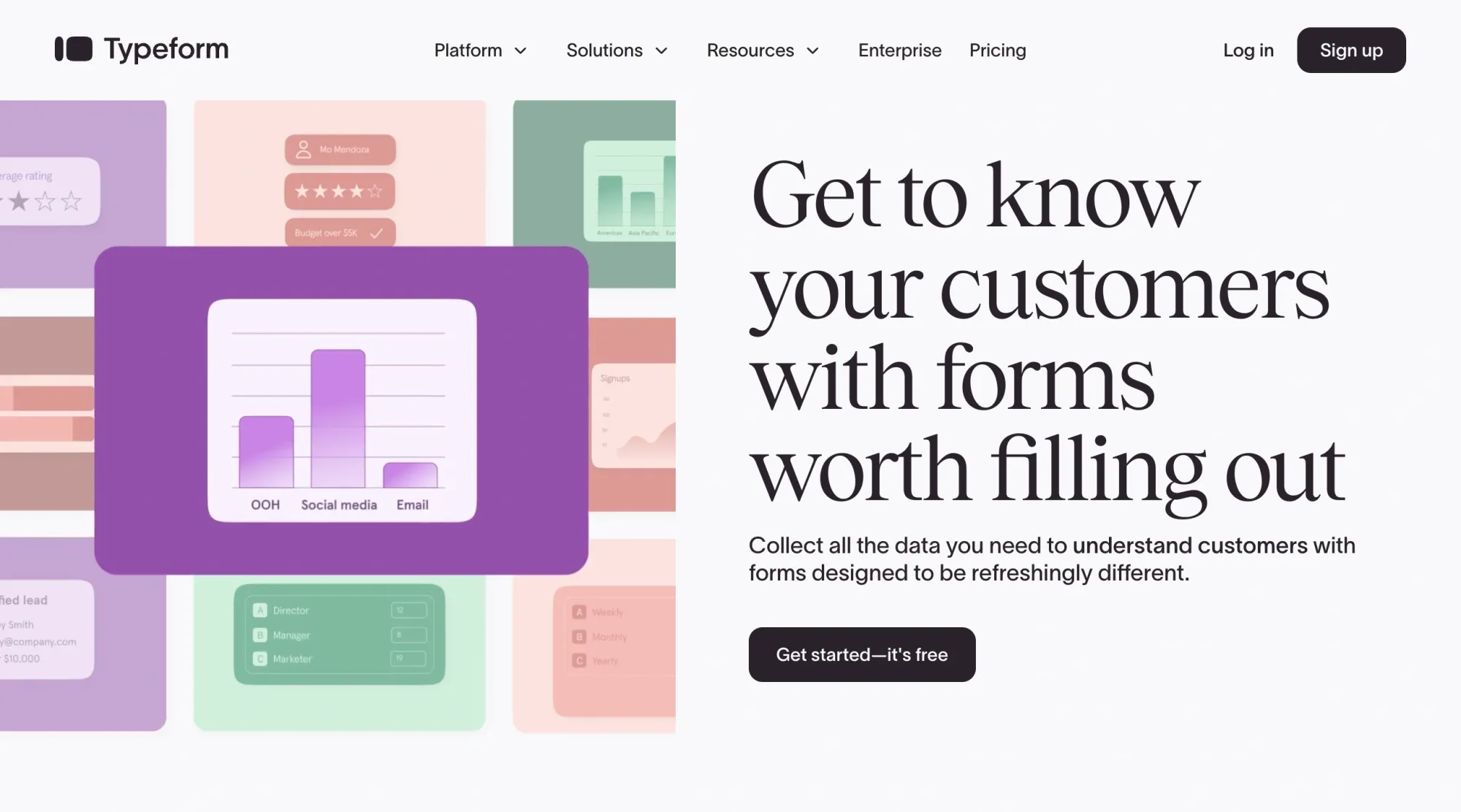
Typeform built its SaaS funnel around showcasing the power of interactive forms and surveys through its own user experience. Their approach demonstrates product value through every touchpoint rather than traditional marketing tactics.
- Product-as-marketing strategy: Typeform uses its own forms for lead capture, feedback, and onboarding. Each interaction shows how engaging forms outperform static alternatives.
- Educational content with embedded examples: Blog posts on survey design and user research include embedded Typeform examples, letting prospects try the product while learning.
- Template-driven adoption: Typeform's extensive template library helps new users get started quickly with proven form designs for different industries and use cases. Templates for customer satisfaction surveys, lead qualification forms, and event registration eliminate the blank page problem for new users.
- Progressive feature discovery: The free tier offers full core functionality with usage caps. As users create more complex forms, they naturally discover features like conditional logic and integrations, prompting upgrades.
3. beehiiv
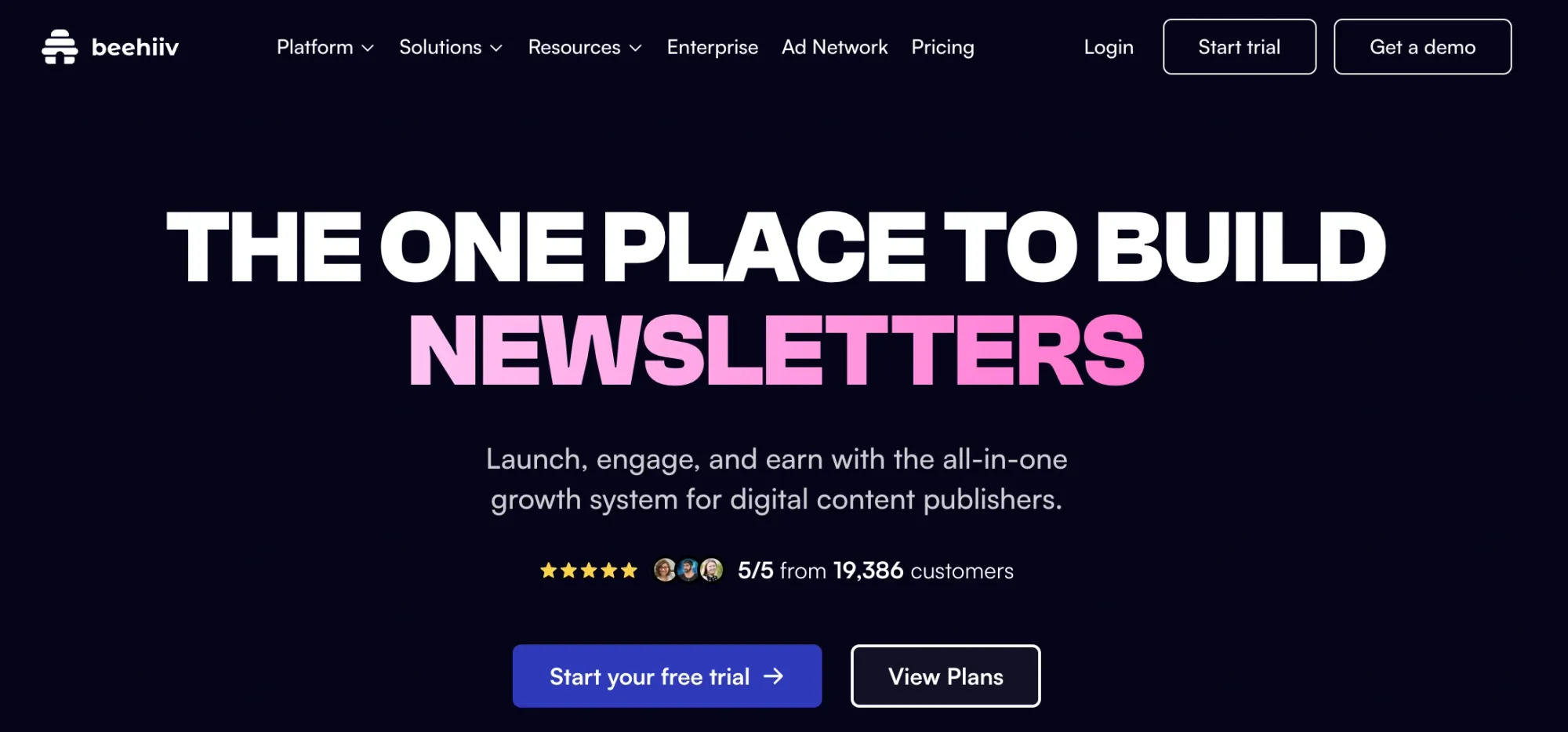
beehiiv entered the competitive newsletter platform market by focusing on creator success stories and product-led growth rather than traditional B2B marketing tactics. Their approach targets newsletter creators who feel limited by existing platforms like Mailchimp or Kit.
- Creator success positioning: beehiiv attracts prospects by showcasing successful newsletters and the revenue creators generate. They position themselves as the platform for monetization, not just email delivery.
- Product-led trial experience: New users can publish instantly without setup hurdles or payment requirements. Onboarding guides them through building a newsletter, importing subscribers, and enabling monetization.
- Community-driven validation: beehiiv builds credibility with testimonials and case studies from successful newsletters. They highlight creator growth metrics and earnings, offering social proof that resonates with prospects.
- Conversion optimization through interactive demos: As part of their funnel optimization, beehiiv uses Supademo to create interactive product experiences that help prospects understand platform capabilities before signup. This approach has resulted in a 20% conversion rate from demo viewers to qualified signups and 50% better free-to-paid conversion compared to their overall website performance, generating over $10,000 in self-serve revenue within two months.
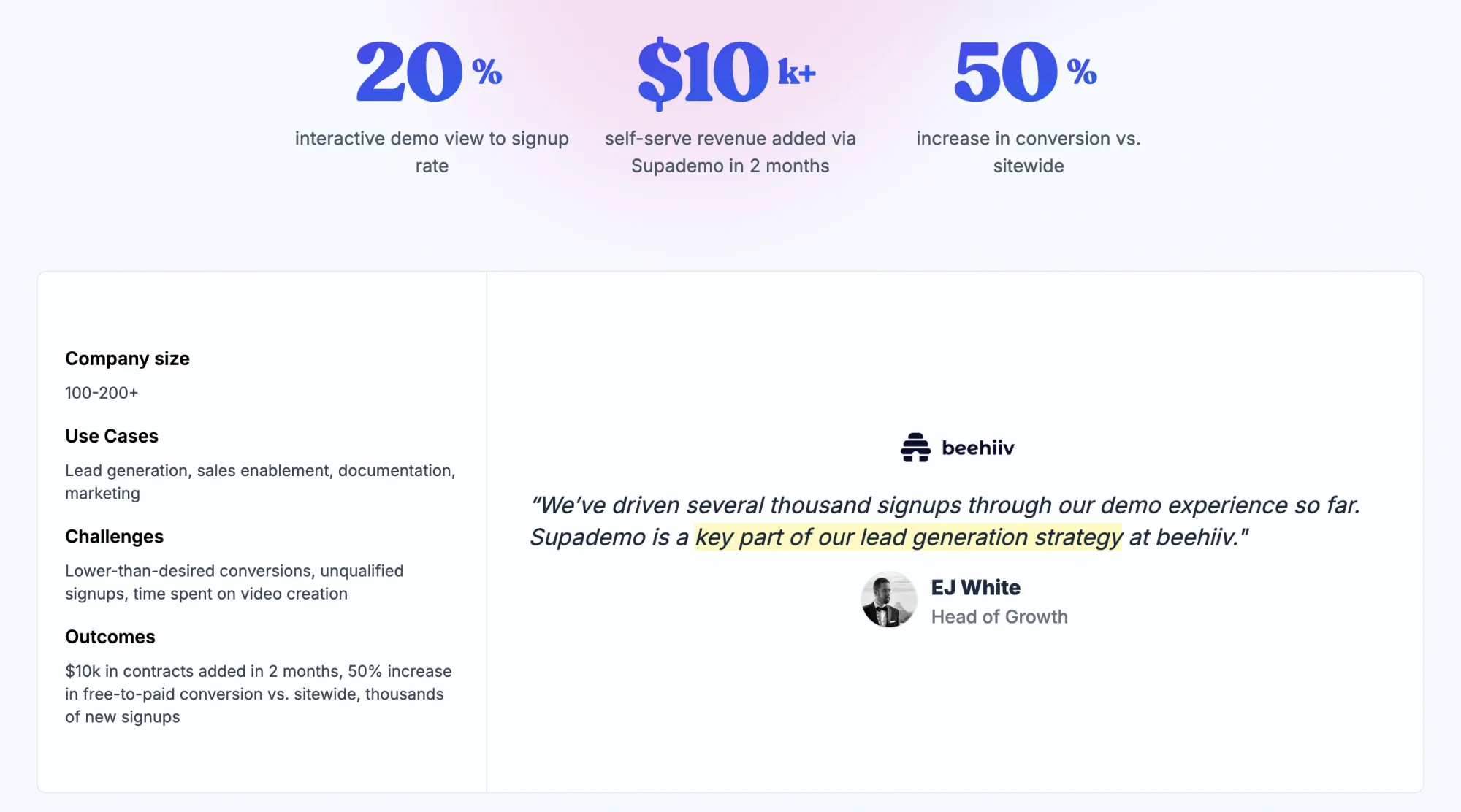
Want to achieve similar results with your SaaS funnel? Supademo makes it easy to create engaging product experiences that convert prospects into customers.
Common SaaS sales funnel terms you need to know in 2025
Accelerate deal velocity and win rates with Supademo
Traditional sales presentations and static product tours create friction in modern B2B buying processes. Prospects want to experience your solution before committing time to sales conversations, but most SaaS companies still rely on outdated approaches that delay understanding and reduce excitement.
Supademo solves this challenge by letting you create engaging, interactive product experiences in minutes rather than hours. Your prospects can explore actual product functionality, see how features solve their specific problems, and build confidence in your solution without scheduling calls or downloading software.
Here's how Supademo improves your entire sales funnel:
- Qualify leads more effectively: Interactive experiences help marketing teams engage prospects with self-paced demo videos that replace static assets and drive qualified opportunities. Companies report a 36% increase in marketing qualified leads converting to sales qualified leads when prospects can explore products hands-on before sales conversations.
- Track prospect intent automatically: Monitor which features prospects explore most with Supademo’s detailed analytics, giving sales teams valuable conversation starters and needs insights before initial meetings. This behavioral data helps prioritize follow-up efforts and customize sales approaches.
- Scale personalization efforts: Create customized demo experiences for different personas, industries, or use cases without additional development or design resources. Hyper-personalized sales materials with intent tracking help engage prospects and reduce customer acquisition costs by 28%.
- Accelerate sales cycles: Prospects arrive at sales meetings already understanding core functionality, allowing teams to focus on value discussions and implementation planning. Companies typically see a 33% increase in deal velocity when highly-engaged prospects move through sales processes with enhanced momentum.
- Improve conversion rates: Supademo’s interactive product demos help you get higher close rates because prospects are more educated and excited about the product before sales engagement begins. Interactive experiences build confidence that translates into purchasing decisions.
Whether you're generating leads through content marketing or closing enterprise deals, interactive demos create the engaging experiences that modern buyers expect and prefer.
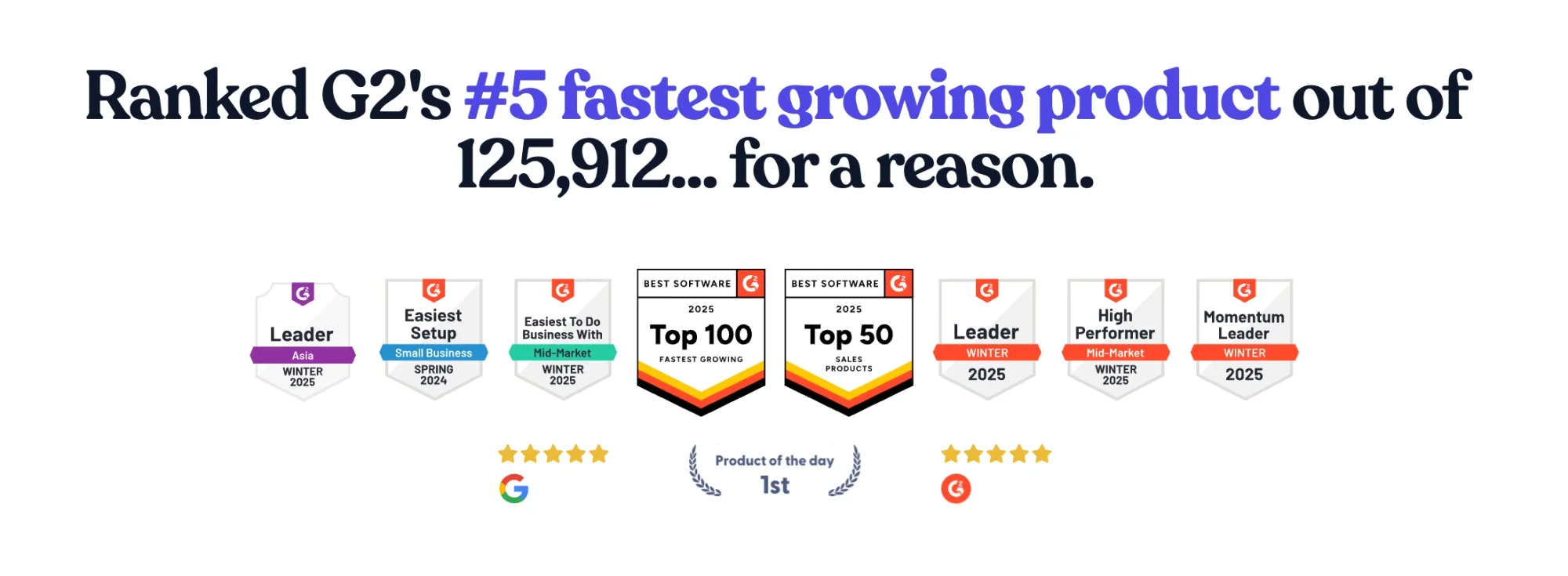
Ready to see measurable improvements in your conversion rates?
Try Supademo for free today and turn more prospects into customers with interactive experiences that work across every funnel stage.
FAQs
What is a SaaS sales funnel?
A SaaS sales funnel is a systematic process that guides prospects through awareness, consideration, and purchase stages to become recurring subscribers. It focuses on long-term customer relationships rather than one-time transactions.
What role do inbound and outbound marketing play in a SaaS sales funnel?
Inbound marketing attracts prospects through content and SEO at the top of the funnel. Outbound tactics like cold email and social selling target specific accounts throughout the consideration process.
How to build a high-converting sales funnel for SaaS?
Start by mapping your customer journey and creating stage-specific content for each phase. Implement lead scoring, use interactive demos, and continuously optimize based on conversion data and feedback.
How to align content marketing with the sales funnel in SaaS?
Create educational content for awareness, comparison guides for consideration, and case studies for evaluation stages. Match content format and messaging to each stage's specific needs and concerns.


